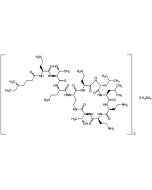Cookie Policy: This site uses cookies to improve your experience. You can find out more about our use of cookies in our Privacy Policy. By continuing to browse this site you agree to our use of cookies.
AdipoGen Life Sciences
Gentamicin sulfate (USP Grade)
As low as
50
CHF
CHF 50.00
In stock
Only %1 left
AG-CN2-0066-G0011 gCHF 50.00
AG-CN2-0066-G0055 gCHF 170.00
AG-CN2-0066-G02525 gCHF 510.00

| Product Details | |
|---|---|
| Synonyms | Apogen; Garamycin; Gentiomycin C; Refobacin; NSC-82261 |
| Product Type | Chemical |
| Properties | |
| Formula |
C21H43N5O7 . H2SO4 (unspecified) |
| MW | 575.6 |
| Merck Index | 14: 4392 |
| CAS | 1405-41-0 |
| RTECS | LY2625000 |
| Source/Host Chemicals | Isolated from Micromonospora sp. |
| Purity Chemicals | Mixture of gentamicin C1, C1a, C2, C2a and C2b. |
| Appearance | White to off-white powder. |
| Solubility | Soluble in water. Almost insoluble in alcohol or ether. |
| Biological Activity |
Potency (dry basis) ≥590μg/mg |
| InChi Key | HNCAOLPMSASREN-UCMBPTNBSA-N |
| Smiles | CCN.CC(C)N.CNC(C)C.OS(O)(=O)=O.CN[C@H]1[C@@H](O)C(OC2[C@H](N)CC(N)[C@H](OC3O[C@H]([*])CC[C@H]3N)[C@H]2O)OCC1(C)O |
| Shipping and Handling | |
| Shipping | AMBIENT |
| Short Term Storage | +4°C |
| Long Term Storage | +4°C |
| Handling Advice |
Hygroscopic. Keep cool and dry. |
| Use/Stability | Stable for at least 2 years after receipt when stored at +4°C. |
| Documents | |
| MSDS |
 Download PDF Download PDF |
| Product Specification Sheet | |
| Datasheet |
 Download PDF Download PDF |
Description
- Aminoglycoside antibiotic.
- Protein synthesis inhibitor. Causes codon misreading by binding to the 30S ribosomal subunit, blocking the translocation of peptidyl-tRNA from the acceptor site to the donor site.
- Antibacterial against Gram-negative aerobic bacteria, Gram-positive bacteria and mycoplasmas.
- Used as a selection agent (gentamicin-resistance gene) in molecular biology applications. Broad-spectrum cell culture antibiotic that is nontoxic to viruses and mammalian cells at antibacterial and antimycoplasmal concentrations. Due to its extended stability and slow development of bacterial resistance, it is a useful antibiotic in long-term virus und tissue culture studies.
- Bactericidal effects are exerted by the binding to the outer membrane, causing disruption of the membrane. This increases the permeability of the cell envelope, leakage of cell contents, and leading to apoptosis and proteolysis (cell death).
- Causes also cell death by generation of free radicals, phospholipidosis, extracellular calcium-sensing receptor stimulation and energetic catastrophe.
Product References
- Gentamicin: antibacterial activity, clinical pharmacology and clinical applications: M. Finland; Med. Times 97, 161 (1969) (Review)
- Aminoglycoside uptake and mode of action--with special reference to streptomycin and gentamicin. I. Antagonists and mutants: R.E. Hancock; J. Antimicrob. Chemother. 8, 249 (1981) (Review)
- Aminoglycoside uptake and mode of action-with special reference to streptomycin and gentamicin. II. Effects of aminoglycosides on cells: E. Hancock; J. Antimicrob. Chemother. 8, 429 (1981) (Review)
- Gentamicin interaction with Pseudomonas aeruginosa cell envelope: N.L. Martin & T.J. Beveridge; Antimicrob. Agents Chemother. 29, 1079 (1986)
- Surface action of gentamicin on Pseudomonas aeruginosa: J. Kadurugamuwa, et al.; J. Bacteriol. 175, 5798 (1993)
- Leupeptin and E-64, inhibitors of cysteine proteinases, prevent gentamicin-induced lysosomal phospholipidosis in cultured rat fibroblasts: J.P. Montenez, et al.; Toxicol. Lett. 73, 201 (1994)
- Gentamicin as gene therapy: F.C. Luft; J. Mol. Med. (Berl) 80, 543 (2002) (Review)
- An integrative overview on the mechanisms underlying the renal tubular cytotoxicity of gentamicin: Y. Quiros, et al.; Toxicol. Sci. 119, 245 (2011) (Review)







